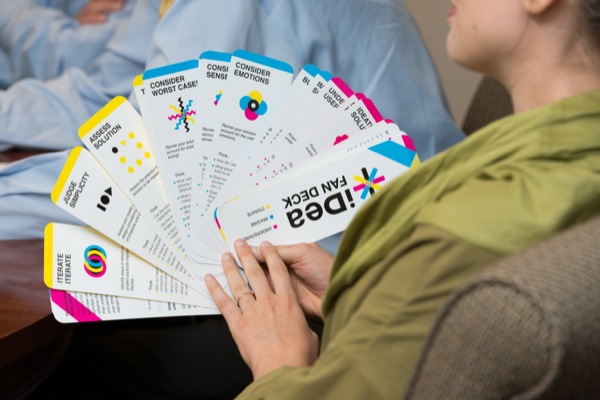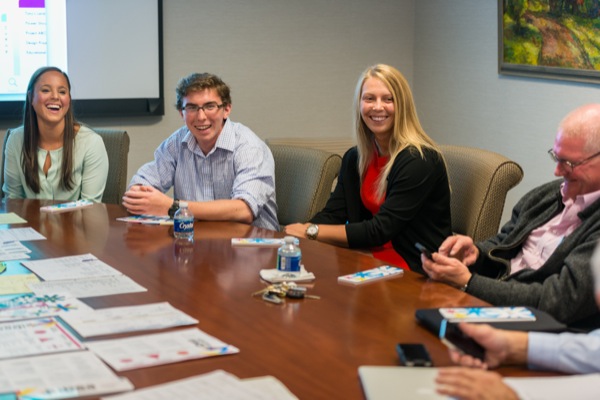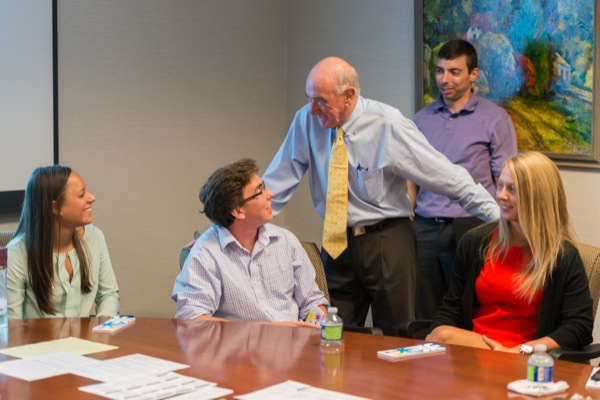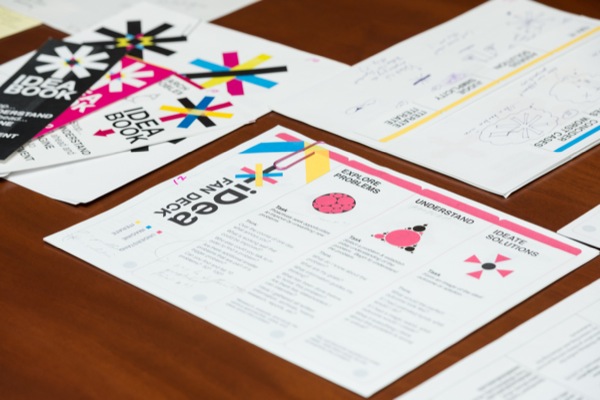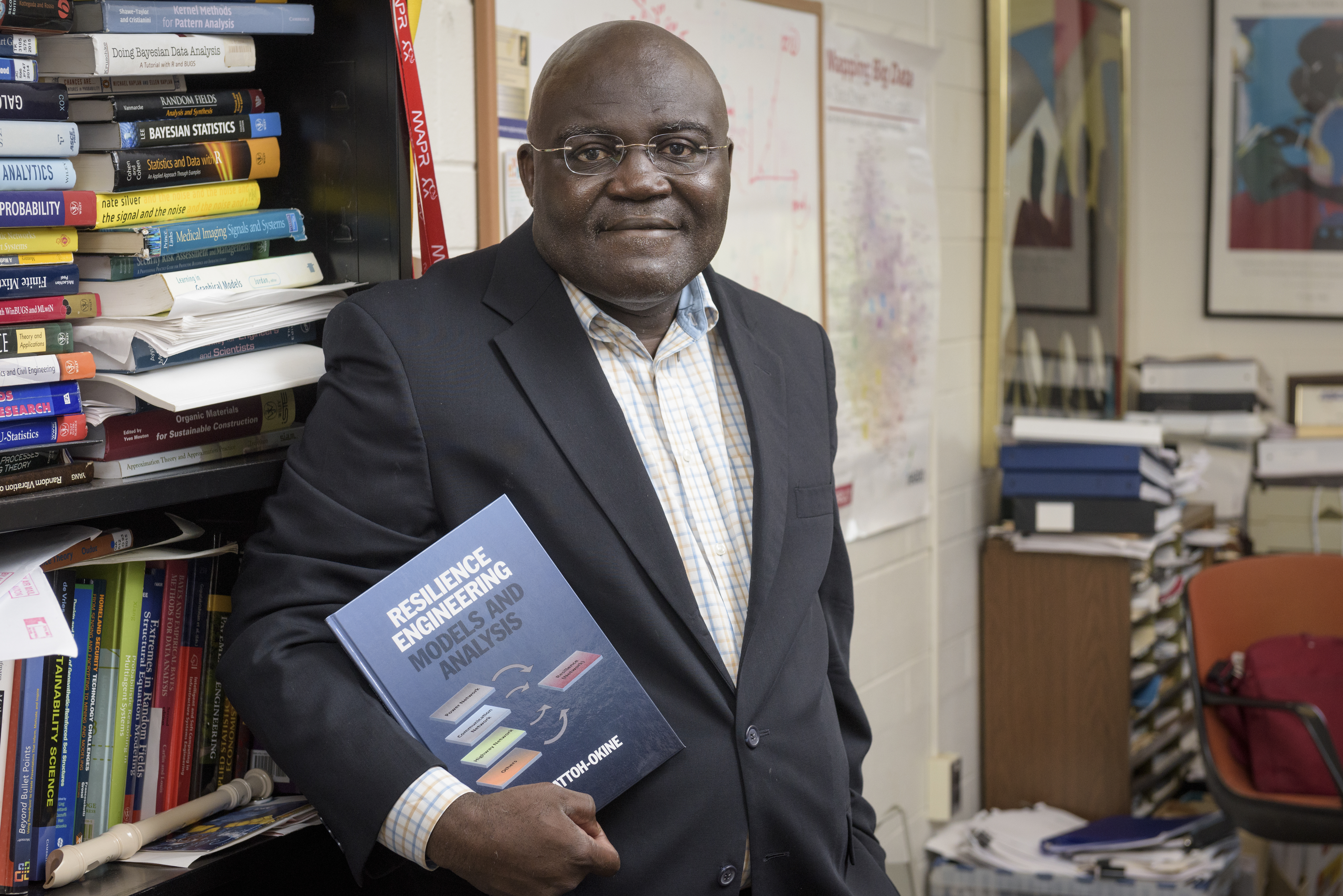iDEA Fan Deck
Interdisciplinary team uses OEIP Spin In program to create iPhone app
2:54 p.m., Oct. 22, 2013--In 2012, University of Delaware faculty members Jules Bruck and Anthony Middlebrooks created the iDEA Fan Deck, a handheld design-based tool that provides prompts for people needing problem-solving help in any field.
The tool was a success but those who used it all had the same observation – that it would make a great iPhone app.
People Stories
'Resilience Engineering'
Reviresco June run
To make that suggestion a reality, Bruck and Middlebrooks, in partnership with the University’s Office of Economic Innovation and Partnerships (OEIP) Spin In program, teamed with three UD students.
Through Spin In, OEIP matches entrepreneurs who are developing innovative early stage technology with a team of UD undergraduate students to further develop both the technology and the marketing strategy.
The student team is mentored by UD faculty and works side-by-side with entrepreneurs to provide solutions to challenges that need to be overcome on the path to commercialization.
After a project has been completed, the technology is spun back out of the University, and the entrepreneur moves forward with plans for product development.
“Spin In arose out of part of our mission, to provide a unique experiential learning opportunity to undergraduate students in the areas of innovation, entrepreneurship and product development,” said David Weir, director of OEIP.
“Working with Spin In is a really amazing opportunity for a business,” said Bruck, associate professor in the College of Agriculture and Natural Resources’ Department of Plant and Soil Sciences, explaining that while their product is a useful tool as a physical fan deck, “it could be more accessible as an app, and more iterative, so we can make updates and be more fluid with it.”
The iDEA Fan Deck is color-coded and icon based, dividing the problem-solving process into three major phases: understand, imagine, and iterate. The tool can be used to address problems from pre-start to implementation, or as a prompt to spark a stalled process.
The graphic design of the original fan desk was created by Keefer Charneau, a visual communication major who graduated from UD in 2012 and has since moved on to work at a design firm in New York City.
“We thought if we could prompt people to pay attention to all the phases of the problem-solving process, then that would be a more effective way of helping them innovate,” said Middlebrooks, associate professor in the School of Public Policy and Administration in the College of Arts and Sciences, who explained that the fan deck went through 17 iterations before the final version was created.
“The fun part about working with Spin In is that it prompted us to really advance the tool itself,” said Middlebrooks. “The app has two or three major features that are above and beyond the physical fan deck. It has a decision tree, a brand new design thinking development facet that is a major feature, and the Spark Me random question generator. The app allows us to do some things that we couldn’t do with the physical fan deck.”
Interdisciplinary student team
The students assigned to work on the project included Candace Galentine, Sarah Minnich and Jacob Nachman.
They all agreed that working in an interdisciplinary team -- something Middlebrooks and Bruck stress in their combined leadership classes -- was greatly beneficial to their educational experience.
“It’s something that you don’t get in the classroom,” said Galentine, an Honors Program junior double majoring in finance and management information systems. “When you work in groups in classes, you’re working with people who are in a similar major. When I’m in a finance class working with a group, they’re finance students, but for this I’m working with a graphic designer and a computer engineer, so it’s completely different.”
Minnich echoed these sentiments, saying, “Working in a multidisciplinary team was probably the most beneficial aspect of the project. I learned a lot about Jake’s discipline and Candace’s discipline, I learned a lot more about their fields, and I’m sure they learned about my field and my background as well.”
Galentine said she started working part-time on the project in February. As the project manager, she worked on many aspects ranging from facilitating meetings and communication between IT, design and entrepreneurs to working on market assessment, developing potential business models, finding business opportunities, forming a project plan, and helping create a wireframe for the project.
Galentine also focused the project on the end user by performing research and testing — both with people who had heard of and used the iDEA Fan Deck and those that had not. It was through this research that Galentine decided to make the app available as a “freemium.”
“The app is free to download, with limited content, and then the rest you have to purchase for $2.99,” said Galentine. “We felt that this would eliminate the barrier for people who don’t know what the iDEA Fan Deck is so they can download the free version, see if they like it, and then be able to purchase it.”
Summer project
Nachman, an Honors Program sophomore majoring in computer engineering, came aboard a month after Galentine. By summer, Minnich joined the team and they were able to work full time on the project.
As the programmer, Nachman was in charge of writing the code and adding functionality to the app, something that he said took anywhere from 200 to 300 hours of work.
Not only did he have to invent the code for the app, something that he had never done before, but he also had to get that code approved by Apple.
“That was a little bit difficult -- it got rejected once and then it took a several updates to get it up to date with everything they wanted,” he said. “But learning how to do the work was great because I had no idea how to do it when I went in to the project; I just had to figure it all out.”
Nachman also said that working with a problem-solving tool came in handy when the group encountered problems of their own on the project. “The iDEA Fan Deck was helpful during the process because when we got stuck, we were already looking at information that could help guide us through the process. I think it’s a very useful tool. I’ve used it for a few projects that I’ve worked on during the school year to get my thoughts started.”
Minnich, who received a bachelor’s degree from UD in 2010 and a master’s in plant and soil sciences this year, and who and now works for OEIP, served as the project’s graphic designer. Having worked with Bruck and Middlebrooks in the past to create one of the first fan deck prototypes, Minnich was familiar with the product from the outset.
“In past courses they’ve taught, they have structured the curriculum to be design challenged-based and the fan deck is a really helpful tool in guiding the students along the way in their design process,” said Minnich.
As a previous teaching assistant for some of those courses, Minnich said that it is interesting to see how students from non-design backgrounds utilize the iDEA Fan Deck. “I think that it is most helpful for them because it pushes them to think in a different way then they’re used to in their regular curriculum.”
As for this project, Minnich said that it was great to work with Bruck and Middlebrooks, who gave the three students the autonomy to make the project their own. “They trusted us and we felt very responsible for what we were creating and we had a real handle on it,” said Minnich.
As designer, Minnich worked closely with Nachman, who would input the code. “Our jobs were pretty intertwined,” she said. “I would design some of the graphics and then he would import them, including things like the buttons, the layouts, fonts, and the backgrounds.”
Minnich said the students agreed that they benefited greatly from working on the project, getting real-world, hands on-experience and learning how to work as part of an interdisciplinary team.
“The whole process started out really rough and there was this level of uncomfortability because none of us had ever worked on designing an app before and we weren’t really sure what it was going to entail,” said Minnich. “But we sat down and made timelines and benchmarks, and the whole process of seeing it come together was really satisfying.”
Click here to download the app.
Article by Adam Thomas






